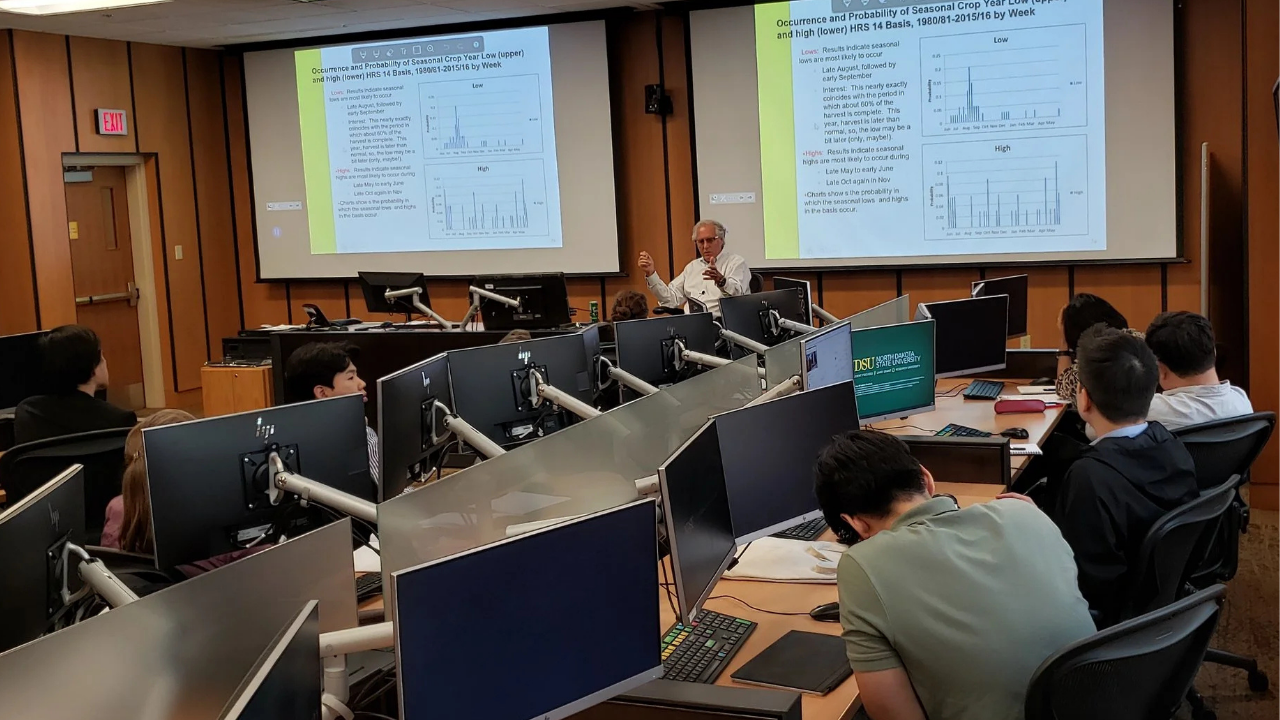Shows about men still dominate our television screens. But the stories being told are starting to change, with more room for vulnerability and portrayals of male mental illness. These changes include explicit mentions of diagnostic…
Blog
-

Q&A: Four Decades of Teaching Global Grain Procurement
Dr. William “Bill” Wilson helped establish the Grain Procurement Management for Importers short course at the Northern Crops Institute (NCI) more than four decades ago. Over the course of his long career, he has worked with hundreds of course participants from across the globe.
Wilson recently transitioned to a new role with North Dakota State University (NDSU) but was still involved in this year’s course. USW talked with him about the course’s history, the core tenets that make it successful year after year, and how the course has been refined over time to meet the changing needs of global grain buyers.
What was the initial driving force behind establishing the NCI grain procurement short course?
At the time the course was founded in 1982, the U.S. marketing system was considered very complicated compared to that of competitors like Australia or Canada. The purpose was that if we better educate buyers about the mechanics of our grain marketing system, then buyers can be more effective in their purchasing strategies. That was the idea, and I would say it still is the idea.
How have course participants changed over the years?
During our first couple of courses, nobody knew what an NCI course meant. One of the first programs was primarily seven people from Iraq who were involved in insect inspection. They were not really involved in the nuts and bolts of procurement, but that was the state of the industry at the time.
Over the next decade, the course increased to about 40 people. We had a lot of simultaneous translation; sometimes we were translating simultaneously into five languages. But the class was largely dominated by government buying agencies, so they had limited discretion as to what they did and their primary goal was to get the lowest cost.
Nowadays, we fill our class every year with 35 students, which is the capacity of our trading room. And we are always at capacity. We now teach multiple courses, one on wheat and corn and one on soybeans.
All of the students today are younger; they’re trained in futures, options and trading; they’re conversant in English and they’re very active in the purchasing of wheat. This is radically different than earlier years. They’re operating in a very competitive environment and using what we consider to be sophisticated strategies for managing risk and procurement.
How has the course been refined to meet the needs of this change in participants?
These are all recently trained people. They’re fully aware of the operations of futures , cash and options markets. When I observe the way we teach and what they ask questions about, they’re doing everything we’re teaching them. What they’re trying to do is fine-tune the way they’re doing it, whereas in earlier years, we were teaching them – what is the futures market?
First, we teach a lot about risk management, and we teach a methodology called Value at Risk (VaR). This is a novel technology and we teach it regularly in our university class. Increasingly, five to 10 percent of students are actively using this already in their import situation. So they’re looking to fine-tune their knowledge of how to use this method.
Second, we have a commodity trading room at NDSU that I developed in 2012. We have 34 workstations replicating what would look like a commodity trading room at any company, and we have access to all of the major media and information sources in the world. So a big part of one of our sessions is to articulate and illustrate all of these sources of information.
We also have online trading during our course. We give them assignments ahead of time, and then they have to trade overnight in groups. It brings the group together.
When we have very volatile marketing periods, it brings out a lot of questions, not only on the mechanics of making a buy decision, but also things like the price ladder and others.
Third, we are spending a lot of time on logistics and supply chain management. Every company in the world is analyzing its supply chain. I asked the students what their biggest source of risk is and it was transit time risk, so we introduced case studies to illustrate the impacts of transit time risk, where you make a purchase, expect shipment in 15 days and it takes 45 days. We now also have a special session devoted specifically to stock holding as a strategy.
How has industry engagement with the course changed?
In the 1980s, trying to get an industry speaker to come to Fargo was a killer. If I asked any company, I want to bring in a group of 30 people that you don’t know, so that you can tell them anything, they would say – forget it! So, I had to lean on former students of mine.
Then, over time, as our audience became more sophisticated and more commercially intriguing, we had no problem having industry speakers. We now have three to five industry speakers. We have traders coming in, we have local shuttle elevators coming in and the BNSF railroad is a regular speaker. As a matter of fact, we have more industry speakers than we can accommodate!
How does the integration of academic and industry experts benefit participants?
It’s good because I’m an academic. We as academics don’t know everything, and we don’t sell wheat, so it’s important to have industry speakers.
And industry speakers typically are not natural teachers. So we have a perfect complementarity now between academic presentations and experienced industry speakers. This has enhanced our program substantially.
How has USW helped contribute to the success of this course?
USW was with us from the very beginning. Most important to me is that USW identifies participants around the world who would benefit the most from this course. All of the overseas staff have been involved in the courses, so they know what we do. USW is like a matchmaker.
I also interact with the USW staff overseas. When they’re at NCI for trade teams and other programs, I always take a little pulse check about what’s of emerging importance and how we need to make marginal changes to the course each year.
How does this course ultimately drive sales of wheat?
When you teach in this class, you’re teaching somebody for their career and for a lifetime. Our approach is to teach the tools that are really important to utilize the flexibility of the U.S. market system.
The tools that we teach are always applicable for U.S. purchases. Over time, the idea is that if buyers are more knowledgeable, they make better decisions. That’s the approach we take.
Continue Reading
-

Quitting smoking after cancer diagnosis significantly extends survival
Around 25% of people with cancer in the U.S. are active smokers when they are diagnosed, and studies have found that many of them continue to smoke during treatment. This may be due in part to a common misconception – even among…
Continue Reading
-
Amazon’s Project Kuiper to launch satellite broadband in Pakistan by 2026
Amazon’s Project Kuiper is set to launch satellite broadband services in Pakistan by the end of 2026, marking a significant step in the country’s digital transformation. The announcement was made following a high-level meeting between Pakistan’s Federal Minister for IT and Telecommunication, Shaza Fatima Khawaja, and a delegation from Project Kuiper on October 9, 2025.
The project aims to deliver high-speed, low-latency broadband via a constellation of up to 3,236 Low Earth Orbit (LEO) satellites. The service will focus on reaching underserved and remote areas of Pakistan, which have traditionally struggled with reliable internet connectivity.
The Ministry of Information Technology and Telecommunication confirmed that key infrastructure, including ground gateways and local points of presence (PoPs), will be established in Pakistan to support the satellite broadband rollout. This infrastructure will help ensure stable performance and seamless integration with Pakistan’s national network, providing internet speeds of up to 400 megabits per second through affordable user terminals.
Minister Shaza Fatima Khawaja welcomed the collaboration, calling it a vital step toward expanding digital access across the country. She emphasized that Project Kuiper’s entry aligns with Pakistan’s vision of becoming a “Digital Nation,” where high-speed internet is accessible to all citizens, regardless of their location.
The initiative is expected to have a significant impact on Pakistan’s IT sector, fostering innovation, attracting foreign investment, and enabling the growth of digital services in areas such as education, healthcare, and e-commerce.
Officials from the Ministry of IT reiterated Pakistan’s commitment to facilitating international partnerships that contribute to the growth of a connected and inclusive digital economy. The arrival of Project Kuiper’s services is part of the country’s broader strategy to incorporate cutting-edge technologies and accelerate its digital transformation.
Continue Reading
-

Intensify Your Audio With a 51% Discount on Beats Studio Pro Headphones
It all started when my beloved Apple AirPods suddenly died one day. No matter how much troubleshooting and finger-crossing I did, they wouldn’t turn on. I finally accepted they’d had a good run and it was time to put them to rest. RIP. Gone but…
Continue Reading
-

A Knight of the Seven Kingdoms: first trailer for new Game of Thrones prequel | Game of Thrones
HBO is headed back to Westeros once again. The network revealed the first trailer for its second Game of Thrones prequel, A Knight of the Seven Kingdoms, at New York’s Comic Con on Thursday, revealing the Targaryen colors, jousting and plenty…
Continue Reading
-
Just a moment…
Just a moment… This request seems a bit unusual, so we need to confirm that you’re human. Please press and hold the button until it turns completely green. Thank you for your cooperation!
Continue Reading
-
Just a moment…
Just a moment… This request seems a bit unusual, so we need to confirm that you’re human. Please press and hold the button until it turns completely green. Thank you for your cooperation!
Continue Reading
-

Annoyed by junk calls to your iPhone? Try the new iOS 26 call screen feature
LONDON — LONDON (AP) — iPhone users have a new tool to combat the scourge of nuisance phone calls: a virtual gatekeeper that can screen incoming calls from unknown numbers.
It’s among the bevy of new features that Apple rolled out with last…
Continue Reading
-

Most Valuable Parent: Wave’s Kailen Sheridan on how soccer, being an aunt prepared her for motherhood | News
I saw an Instagram post of you doing the sympathy exercises with your wife, which was so funny. What did you learn and how did that come about?
I had seen somebody else do it on social media, so I was like, “Oh, yeah, I’m definitely gonna try…
Continue Reading
